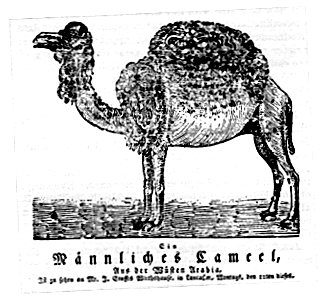A CAMEL IN LANCASTER
By William F. Worner, in Old Lancaster Tales and Traditions, published by the author, Lancaster, PA 1927, pp. 82-85.
![]()
A century or more ago, camels in this country were regarded as curiosities. On their rare appearances they were, usually, exhibited in stables attached to taverns in cities and towns. The public paid a good admission price (for those days) to get a look at these ungainly animals from the deserts of the Far East.
When was the first camel seen in Lancaster? A camel was exhibited in Philadelphia as early as 1740, according to a statement in Scharf and Wescott's History, Vol. 2, page 864; but whether or not it was brought to Lancaster and placed on exhibition, is not now known. Lancaster, at that time, had not attained the distinction of being a borough; in reality, it was only a small town of a few hundred inhabitants.
We have indisputable evidence, however, that a camel was exhibited in Lancaster as early as February, 1793. It attracted much attention, and, doubtless, was seen by many citizens of the town and vicinity.
In an old German weekly newspaper published in Lancaster and bearing the euphonious and high-sounding title of Neue Unpartheyische Lancaster Zeitung, und Anzeigs-Nachrichten (New Nonpartisan Lancaster Gazette, and News-Advertiser) appears the following advertisement, under date of Wednesday, February 6,1793, of which this is a free translation:
"A
"MALE CAMEL
"FROM THE DESERT OF ARABIA
"May be seen at Mr. J. Stofft's tavern, in Lancaster, Monday, the 11th instant. This stupendous animal is most deserving the attention of the curious, being the greatest natural curiosity ever exhibited to the public on this continent. It is twelve hands high; its neck is four feet long, has a large high bunch on its back, and another under its breast, in the form of a pedestal, on which it supports itself when lying down; it has four joints on its hind legs, and will travel twelve or fourteen days without drinking, and carry a burthen of fifteen hundred weight. It is remarkably harmless and docile, and will lie down and rise at command. "
This was the fullest advertisement that had, as yet, appeared in this old German paper. Accompanying the advertisement was a crude drawing of an Arabian camel, probably printed from a wood cut. The advertisement occupied a space 5 1/2 by 6 1/2 inches. This was quite remarkable for that early period, and gives one some idea of the attention the animal received when we consider that the sheet on which the newspaper was printed measured only 9 1/2 inches wide by 15 1/2 inches long. How long the camel remained on exhibition here cannot now be stated with any degree of accuracy. In the succeeding issue of this German newspaper, bearing date Wednesday, February 13, 1793, appears a somewhat briefer advertisement, with the same crude drawing of the camel, in which is the following statement:
"A male camel from the desert of Arabia, one and twenty hands high. It may be seen at Mr. Jacob Stofft 's tavern in the city of Lancaster."
From this it is but natural to infer that the camel was still on exhibition in Lancaster as late as February 13. In the first advertisement, it is stated that the animal was twelve hands high; while in the latter its height is given as twenty-one hands. It is inconceivable that it increased to such a height in these few days. Evidently, one of these advertisements was carelessly written. It also refers to Lancaster as a city, whereas it was only a borough at that time. "Stadt" is the word used in the German, and stadt, in English, is city.
Jacob Stofft, innkeeper, owned the property at the northeast corner of North Prince and West King Streets and also the property adjoining it on the east. At the present time, D. H. Mosemann conducts a grocery store on the corner, and the Manhattan Hotel is located on the property adjoining it. Stofft undoubtedly kept tavern at one of these places, either in the building on the corner or in the one adjoining it; and in one of these the camel was exhibited.
It is quite probable that another camel was exhibited in Lancaster a few years later, although conclusive proof is lacking for this assertion. It is known for a certainty, however, that a camel was exhibited in the town of York, Pa., in 1796. In an old German newspaper entitled Die Unpartheyische York Gazette ( The Nonpartisan York Gazette), and dated Friday, June 10, 1796, appears the following advertisement:
" CAMEL. " In the stable which belongs to the owner of this printing press one can see a camel.
"The price for one observation of this rare animal is eleven pence."
Mr. George R. Prowell, the eminent historian of York, states that the printing press mentioned in the advertisement was located on West Market Street, between David Candler's store and the Reformed Church, on the south side, nearly midway between Center Square and Beaver Street, York.
In an old book of municipal records of the borough of York, unearthed by Mr. James W. Shettel, that indefatigable student of historical research, appears the following memorandum, under date of 1796, no month mentioned:
" Christopher Stair, High Constable, Dr. To a fine re- ceived from Persons showing camel. 3 [pounds], 0 [shillings], 0 [pence]."
All such brief glimpses of the past are interesting sidelights on the history and progress of our beloved Lancaster, and show us that in the early days animals, especially the camel, contributed to the interest of life in the newly founded United States and catered to that curiosity about animals which has made Americans a circus-loving people.
![]()
Return to the Lancaster County Genealogy Project
